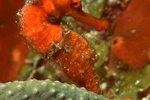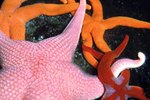
Despite their name, purple sea urchins (Strongylocentrotus purpuratus) aren't always purple in color, ranging from olive green to pink. Like all echinoderms, they live only in marine environments, and can be found all along the Pacific coast, from Alaska to Mexico. Various adaptations help these sea urchins thrive in their environment.
Spiny Solutions
Purple sea urchins can be characterized by their many spines. These aren't just for show, but have several valuable uses. Although only around one-third of an inch long, they're sharp and can help protect the urchins from potential predators. Moving their spines in conjunction with their tube feet also helps purple sea urchins to move. In addition, they can trap floating algae within their spines, gaining themselves an easy meal. Finally, these spines can wear away soft rock, giving the urchin a depression in which to hide. Though the spines are also worn down by this action, they readily regrow.
Aristotle's Lantern
When it comes to purple sea urchins, Aristotle's lanterns aren't really lanterns at all, rather the name of their mouths or jaw structures. These mouths are comprised of five bony plates or teeth and allow them to easily scrape algae—their main food source—off rocks. Their Aristotle's lanterns are also strong enough to bite off chunks of rock from the substrates on which they live. This can help in building defensive pits.
Rapid Adaptation
Purple sea urchins have the ability to rapidly adapt to the conditions of their surroundings, according to a recent study published in the journal "Global Change Biology." The ocean is expected to absorb more carbon dioxide in the future, reducing the amount of calcium carbonate in the water and making it overly acidic. This change would effectively give purple sea urchins osteoporosis if they couldn't adapt. However, researchers found that young members of the species who were exposed to higher levels of carbon dioxide rapidly adapted to withstand these new conditions.
Grouping Up
Although purple sea urchins are usually solitary and independent creatures, they will come together to stay safe from predators and the elements. Using their sharp spines, they'll burrow together into the sand or rock, giving themselves some extra protection. In fact, they're often seen with sand covering parts of their bodies. They're also willing to forget about their solitary ways when a good food source is available.
References
Photo Credits
-
Liquidlibrary/liquidlibrary/Getty Images




